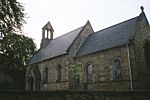St Chad's College, Durham

St Chad's College is a recognised (independent) college of Durham University in England, founded in 1904 as an Anglican hall for the training of Church of England clergy. The main part of the college is located on the Bailey, occupying nine historic buildings at the east end of Durham Cathedral. It neighbours Hatfield College to its north, while St John's College and St Cuthbert's Society are to its south. The college is named after St Chad of Mercia, a seventh-century bishop. Although it is the smallest of Durham's colleges in terms of student numbers (in 2018–19, the college had 409 undergraduates and 150 active postgraduates), it has the largest staff, extensive college library facilities, and among the highest undergraduate academic results in Durham.
Excerpt from the Wikipedia article St Chad's College, Durham (License: CC BY-SA 3.0, Authors, Images).St Chad's College, Durham
North Bailey, Durham Viaduct
Geographical coordinates (GPS) Address Nearby Places Show on map
Geographical coordinates (GPS)
| Latitude | Longitude |
|---|---|
| N 54.772925 ° | E -1.574695 ° |
Address
Langford House
North Bailey 21
DH1 3EW Durham, Viaduct
England, United Kingdom
Open on Google Maps










